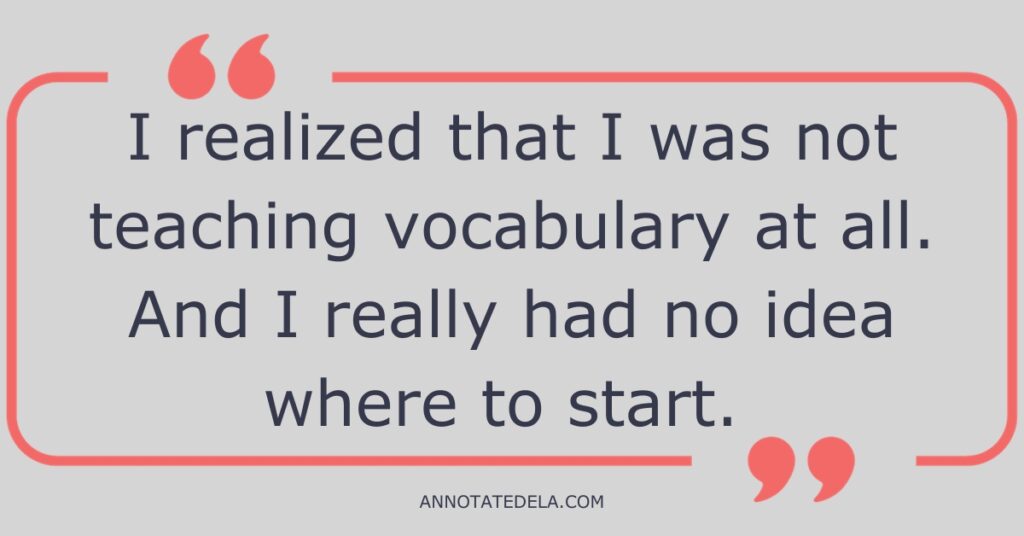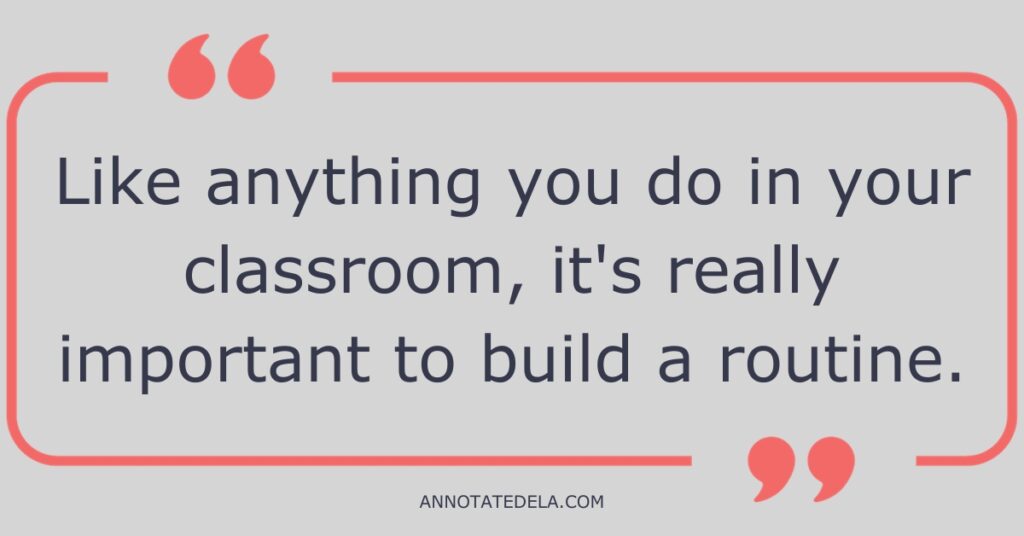Word meaning is not a simple definition of a word and hoping the students will remember. Words have shades of meaning and context plays a role in what the words mean. This makes vocabulary instruction feel overwhelming. But, building a word conscious classroom does not need to be one more thing to do.
Building routine and helping students explore words on their own will streamline word meaning. Join Liz Puma, from Vocabulicious, as she shares low investment, high return ways to incorporate vocabulary instruction across the whole school day.
You can find Liz at vocabulicious.com and her resources on TPT

Why Focus on Vocabulary Instruction?
“Well, it’s a little embarrassing to admit. But when I was maybe three or four years into teaching fourth grade, I realized that I was not teaching vocabulary at all. And I really had no idea where to start.”
Liz was feeling overwhelmed with where to start with vocabulary instruction and helping her students make word meaning. She was a busy teacher who did not have time for more professional development classes that throw books at you and bury you in theory. Even though some of those books are helpful, she needed to make her own way.
Googling only took her so far. This is when she realized she would have to dive head first into creating a space for other teachers to get vocabulary tips and activities. She dug into the research and started her blog.
Vocabulary instruction is important for students to make word meaning and context meaning. The foundation that words make in a student’s comprehension pays off in dividends if teachers can expose students to words on a regular basis.
Where to Start to Help Students Make Word Meaning
Liz was doing an interactive read aloud at the beginning of the day with her students and decided to find a way to weave word meaning and vocabulary instruction into her read aloud time.
Character Trait Vocabulary
She started with character trait vocabulary, because that was threaded easily into the interactive read aloud. Most books were talking about characters. Liz also found that when talking about their family, or about a classmate, it was easy to say, “That classmate is compassionate,” or “This one is obnoxious.”
She got the list from a professor at the University of Wisconsin, Professor Patrick Manyak.
He did some research, it was called the Character Trait School Approach. He immersed every grade level into a list of 20 character trait words throughout a school year, and then tracked their progress. Find a traits list by grade level K-6 here.
That was a great place to start, because she knew it worked, it was only twenty words to kick off, and then she would relate it to a read aloud and offer additional practice.

Finding Words Outside of Character Traits
Find a good tier one and tier two word list.
Liz read somewhere that there’s over 80,000 words in the English language, this makes it really hard to know where to start.
“So you’re going to find 1000 lists online. Honestly, no matter what words you teach, they’re words that kids didn’t know before you taught them. So obviously choose a list, first of all that’s relevant, and second, words that they’ll actually use and that are age appropriate. And then from there, incorporate it into things you’re already doing.”
The best advice is less is more, if you try a whole big list at one time, they’re not going to learn the definition or make word meaning of any of them.
Teachers should pick a handful of words with a handful of strategies and stick with that for a week or two over and over again. Then restart the next cycle later in the month.

Tips to Make Word Meaning Stick
Liz suggests building a routine as the first step in vocabulary instruction, “Like anything you do in your classroom, it’s really important to build a routine.”
Interactive Read Aloud and Interactive Notebook
Liz’s favorite way to incorporate vocabulary and word meaning is interactive read aloud.
“I was doing that every day. Anyway, I absolutely loved that time. That was a sacred 20 to 30 minutes, usually during our morning meeting of our day, and it was easy to pull out two or three words from the book, and use those for a few days.”
Liz also suggests that middle school teachers make it bell work the first few minutes of the period, or use graphic organizers to help teach new words.
She says, “The best thing to do is to make sure that kids are getting a lot of exposure to the same word over and over again, the quality of their word knowledge is much more important than how many words you teach in a year.”
Liz’s second favorite tool is interactive notebooks. Having one dedicated for vocabulary and new word learning is a great way to not only help them to keep track of words, but also to refer back to the definition.
“It’s going to make them their own little personal journal or dictionary. And it really helps you to keep the words alive all year, because when they ask, “What was that word on the word wall?” They can go back to their journal.
Word Wall
Liz read that the average student needs exposure to a word of 40 times before the word really sticks.
Referring to a word 40 times in a month is not probable, but the more you can refer back to a word, the better.
A really good way to do that is to have a word wall in your classroom. Post the words up on the wall that you’re teaching and actually refer back to them, don’t let them collect dust.
Liz noted that when she started testing different strategies she, “…always provided a graphic or a picture or diagram that matched the meaning of the word.”
This helped students that aren’t on grade level read the word off the word wall months later.
Also, for visual learners, having a graphic was a tool for them. The graphic helps to jog their memory and make that connection.
As teachers get more words on the wall, students start to talk about what words are connected to other words that they’ve already learned. Students might even start to categorize the words.
Categorizing helps word meaning stick because they’re putting them into different buckets.
Using the Words in Writing
Liz would have students do writing prompts in their journal that they would use the vocabulary word in the prompt. Teachers can track the writing from beginning of year to end of year throughout that notebook.
Liz would encourage students to use the words in their writing, and maybe in a think pair share type of conversation to help increase the exposure to the word over and over again.
Another tip is to teach words that students will naturally use and easily incorporate into conversation.
This use will transfer to writing, there’s really no better way. Using relevant words is the golden ticket.
If a teacher gives obscure words that are not commonly used, it’s going to feel so awkward for them to incorporate it into their writing.
So that’s really the first step; choosing a list, sticking with it, making sure it’s relevant and age appropriate, and then providing opportunities to use the words in their writing.
Want to build word meaning with your students? Build vocabulary instruction into your routine where it makes sense, expose students to the words you use as many times as you can, referring back to them as often as possible. Word walls and notebooks are your friend. Do what you can with what you have and word meaning will happen!
If you want more support on vocabulary instruction you can find Liz at vocabulicious.com and her TPT store.



